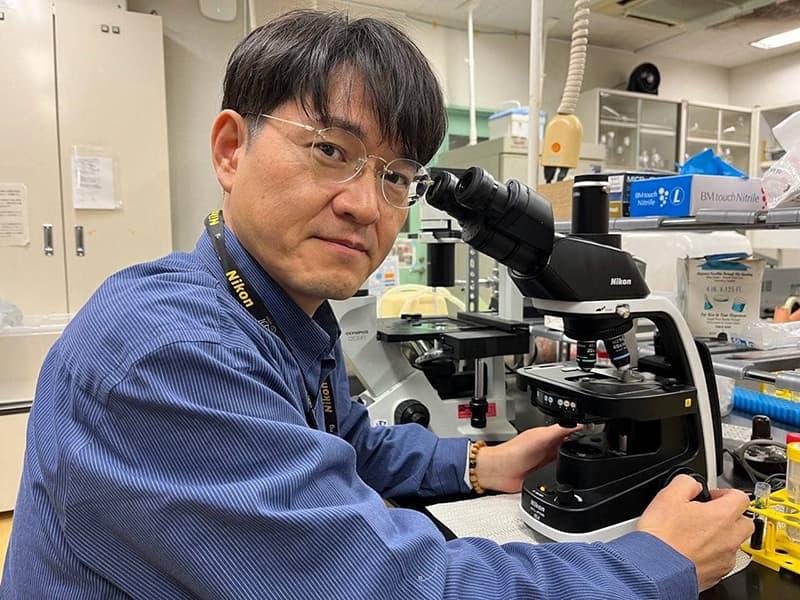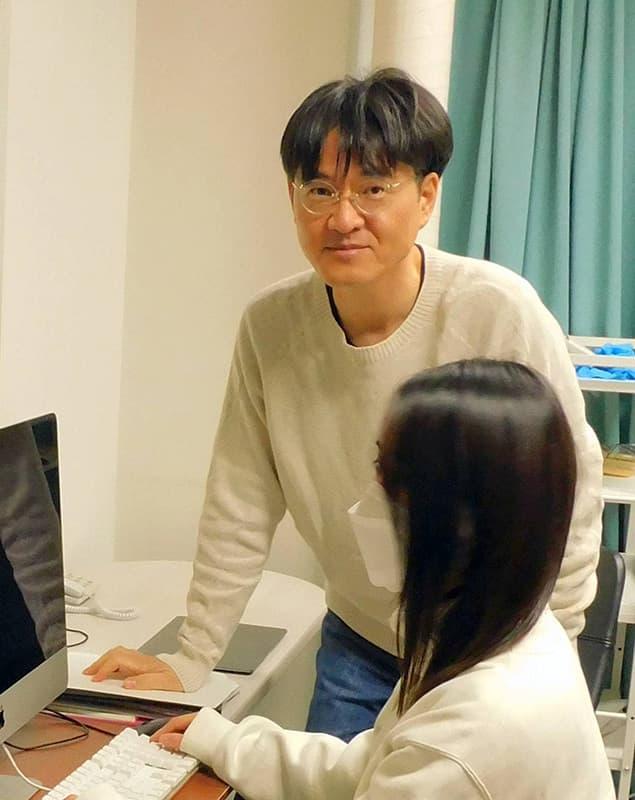TSUKUBA FUTURE
#125 Multi-disciplinary Approach for Unveiling the Mysteries of the Reproductive Mechanism
Assistant Professor ASANO Atsushi, Institute of Life and Environmental Sciences

Reproduction is a fundamental function of life that creates new individuals of the same species. Professor ASANO has been working to elucidate the reproductive mechanisms of animals, including humans, by focusing on the differences and similarities in spermatozoa function between birds and mammals. "Spermatozoa are transcriptionally and translationally inactive. What makes unique cells behave correctly, as they need to function? This research primarily focuses on clarifying the fundamental mechanism of species continuity," says Professor ASANO.

Professor ASANO says, "What I'm most interested in these days is the relationship between reproduction and evolution."
Professor ASANO, a former postdoctoral fellow at Cornell University's College of Veterinary Medicine in the U.S., arrived at the University of Tsukuba in 2012. He had previously studied mammalian reproduction utilizing mutant models; however, he extended his research focus to bird sperm biology by applying a long-standing concept, the "membrane rafts." Animal cells are wrapped in cell membranes that are composed of lipids and proteins. Recent studies have revealed that cell membranes contain small and dynamic regions in which functional lipids and proteins are concentrated. These regions play a central role in cell fusion and adhesion, as well as in traversing information transduction from the extracellular to intracellular compartments. These regions are called "membrane rafts" because they move across the plasma membrane like a floating "raft" in a sea
At Cornell University, Professor ASANO investigated the function of membrane rafts in the fertilization process of mouse spermatozoa. Although nothing is known about membrane rafts in avian spermatozoa, Professor ASANO believed that membrane rafts are one of the common systems used by animals to regulate cellular functions at different temporal and spatial scales, so they should also be present in birds. However, it would be more surprising, even if there were no rafts, so he tested this hypothesis.
The hypothesis was realized and further refined. First, Professor ASANO confirmed the presence of membrane rafts in the head of chicken spermatozoa and found that they are more extensive than what was known from mammalian studies. Further attempts at their functional characterization demonstrated that they are involved in an exocytotic reaction (called the acrosome reaction) that brings the sperm into a state where it can penetrate and fuse with the egg.
Utilizing the functional concept of membrane rafts, he found that cryopreservation compromised chicken sperm fertility by reducing the amount of lipid sterols in membrane rafts. Because of poor tolerance to low temperatures, cryopreservation of chicken and other poultry sperm is not practically available. To test this finding, he controlled the amount of lipid sterols in chicken spermatozoa to avoid lethal damage during cryopreservation, resulting in a sharp potentiation in cryopreservation tolerance.
In recognition of this research series, Professor ASANO was awarded the Japan Poultry Science Society Award in 2021.

He engages in extensive discussions with students during the seminar.
Professor ASANO did not set out to become a reproductive biologist from the beginning.
From his undergraduate to master's program, he mainly studied animal reproductive technologies involving cryopreservation of mouse embryos and in vitro fertilization in pigs. Based on these skills, he began working at an infertility clinic to implement human-assisted reproductive technology. After two years of clinical work, he realized that many cases, regardless of the hope of having a baby, did not come true even after advanced fertility treatments due to various dysfunctions associated with eggs and sperm. This made him believe that unless the mechanisms are clarified, there will be no fundamental solution to human infertility, which then led him to return to graduate school to earn a doctoral degree and conduct reproductive biology research in the U.S.
In 2018, Professor ASANO and his colleagues revealed in an experiment using mutant mice that a deficiency in taurine, an amino acid, in sperm can cause infertility. They found that sperm that invaded female reproductive organs could not maintain motility without taurine. Sperm lack taurine synthesis ability and thus usually absorb it as it passes through the epididymis, a post-testicular male reproductive tract. Defects in this mechanism lead to infertility, which is only identified after the sperm invades the female reproductive tract. This achievement contributes to the investigation of the causes of idiopathic infertility in humans, and it means a lot for him because this is one of his dreams from his graduate school.
Professor ASANO's current primary interest is the relationship between reproduction and evolution.
Although birds' sperm were mentioned as having poor tolerance to low temperatures, once they enter the female reproductive organs, they remain capable of fertilization for an extended period. It is approximately three weeks for chickens and approximately 16 weeks for turkeys. In contrast, the sperm of domestic mammalian animals, such as cattle and pigs, can retain fertilization for approximately one day.
Professor ASANO says, "Birds have taken to the skies, but they cannot mate while in flight and possibly suffer their species continuity. If sperm can maintain their fertilizing ability for a prolonged period in females, they can continue laying fertilized eggs for a long time during a single mating. This is how they have adapted and evolved to ensure the species' survival."
In collaboration with Professor Vimal Selvaraj of Cornell University in the U.S., Professor ASANO tackled the question of why chicken sperm quickly lose their fertilizing ability under refrigeration. As a result, they found that the removal of calcium ions from inside and outside the cells could prolong the preservation of sperm fertilizing ability for a long time. Further experiments seeking a mechanism underlying this phenomenon showed that calcium removal suppresses the energy metabolism of sperm, putting them in a dormant state. Calcium acts as a switch that deactivates and reactivates the sperm's fertilization function. "It may also be involved in the reproductive strategy of avian sperm that await ovulation for a long period in the female reproductive organs," he believes.
Poorly cryotolerant avian sperm benefit tremendously from refrigerated storage technology for practical use. In such cases, it enables mass preservation at a lower cost and with greater convenience than cryopreservation. This could contribute not only to poultry farming but also to the conservation and propagation of rare birds.
Because reproduction is a fundamental function of a species, the results of this research will lead to a wide range of fields, from industrial applications to species preservation, to elucidate the mysteries of evolution.
Article by Science Communicator at the Bureau of Public Relations
Related Link
Assistant Professor ASANO Atsushi
Institute of Life and Environmental Sciences


